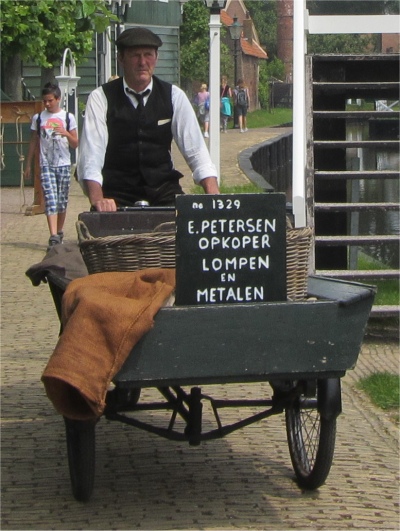
E. Petersen - Buyer of Rags and Metal
|
We stopped for a coffee and apple tart at a pleasant wee cafe that overlooked the Drommedaris that lay just past a short bridge. The tower is a relic of the town's fortifications (1540). The tower, which was heightened in 1649, has a carillon by the Hemony brothers which ranks among the finest in the Netherlands. It served at one time as a prison, and some of the cells can still be seen.
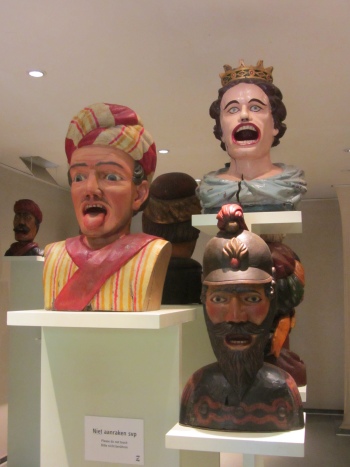
Gapers
|
The cafe had a couple of German women customers, and later the customer count included a couple of oversized Dutch ladies. The most popular customers though, popular in the sense of large numbers, were the feathered variety. Sparrows, ravens and a gorgeous white duck all hovered about for crumbs. The sparrows and ravens were quite brave and would sneak up to snatch a few morsels if they weren't shooed away.
We ambled across to the Drommedaris and surveyed the various harbours and waterfronts from this vantage point, before following the old fortified city wall.
This conveniently took us to the Zuiderzee Museum, a museum created to preserve historic aspects of the Zuiderzee before its past was forgotten. With the threat of rain ever present, we decided to tackle the open air part of the museum first. This component of the museum was very much like the Beamish museum in the northeast of England. Buildings had been lifted and shifted here from various parts of the Zuiderzee area, such as Purmerend and Amsterdam, the museum reflecting life in the villages around the Zuiderzee throughout history.
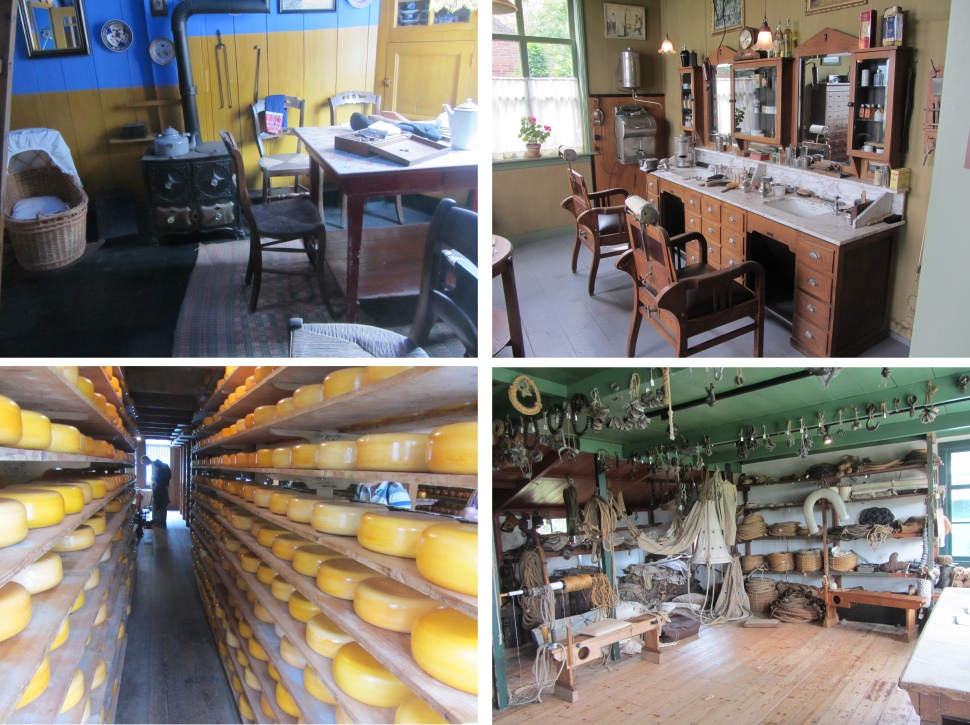
Interiors of Some of the Outdoor Museum Buildings
|
The outdoor museum was buzzing with droves of school children, all excitably shouting (talking is for wimps it seemed) and several groups armed with clipboards containing activity sheets were eagerly searching out answers to the questions posed. One group of children were all dressed in traditional Dutch clothing, and clomped away down the cobbled paths in their clogs (clomp by the way is Dutch for clog).
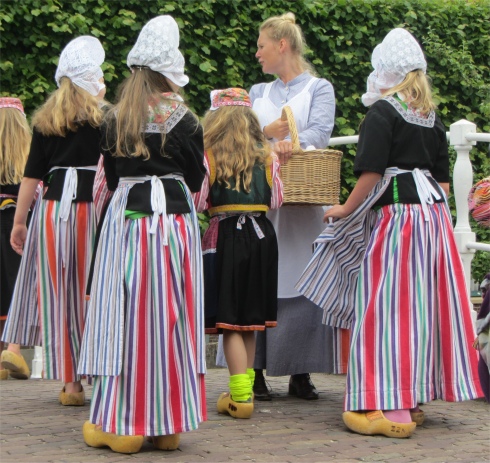
Klompen (Clogs)
|
Between the indoor museum and the open air museum was a recreation of the harbour at Marken, with smokehouses for preserving herring and eels standing on the dike, and fishing boats tied up at the dock. The open air collection had been constructed to look like a cobblestone-street village, complete with a church, school, pharmacy, market area, patisserie, and fishing village. It covered 15 acres and accommodated 130 complete, authentic buildings from the former Zuiderzee region, such as a church, a fish-curing shed, a mill, a cheese warehouse, shops, farmhouses, public buildings and dwelling houses from the surrounding fishing villages, all furnished in period style and some of them with beautifully tiled interiors.
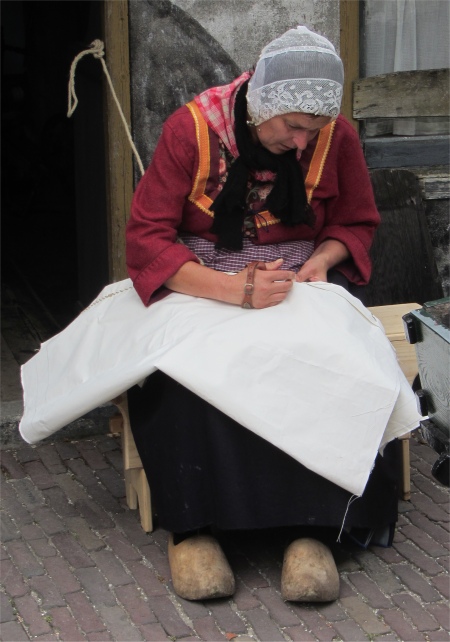
Sail Maker
|
To the north, a working polder mill twirled its sails atop the dike. Nearby was a functioning smokehouse, where workers preserved herring by smoking them over smouldering wood chips before packing them in barrels. The village church hailed from the former island of Wieringen, which now lies inland surrounded by polders northwest of Enkhuizen. Outside the sail maker's store, we watched sails being made by a women, that later would fill with wind aboard traditional Zuiderzee boter and skūtsje sailing ships. In a group of houses from Urk on the Ijsselmeer's eastern shore, daily scenes from around 1905 are re-enacted. The apothecary was an interesting visit, if only for its ornamental "gapers", painted heads with open mouths on display. Among other buildings, all of them functioning concerns, are a grocery store, a cheese warehouse, a post office, a bakery, a painter's store, and a steam laundry complete with a working steam engine. Some of the buildings contained sweet shops, one specialising in drop (liquorice - a Dutch favourite). Others contained demonstrations such as brush making, smithy, and I even got roped into making rope (excuse the play on words). Towards one end of the museum three bottle-shaped limekilns stood with their necks craned high. They utilised seashells as the raw material for making quicklime. As we inspected these, a passenger boat arrived at the small quay by the kilns and disgorged dozens of folk who rapidly infiltrated the museum.
One of the rooms contained a video presentation showing fishermen going about their business on a frozen Ijsselmeer, using holes cut in the ice. A nearby story board gave a harrowing account of a true incident that occurred on 13th-27th January 1849. Klaas Bording (45), and his sons Klaas (19) and Jacob (17), lived in the fishing village of Durgerdam just north of Amsterdam on the Zuiderzee coast. The winter of 1849 was very severe, and part of the Zuiderzee was frozen. On these occasions, the fishermen would engage in botkloppen, fishing through holes cut in the ice. Nets and baskets would be carried out to these holes using sleds.
On the 13th January, Klaas and his two sons set about botkloppen, and they found a good location with lots of fish near Muiden, and fished on until deep in the night. It was only at 2am that they realised they were now drifting on an ice floe in the sea.
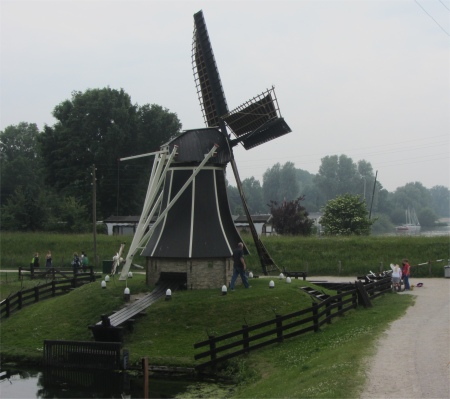
Polder Drainage Mill
|
They then drifted around the Zuiderzee for two weeks, where they endured a bitter struggle with the bitter cold and lack of food and drink. They were eventually rescued by fishermen from Vollenhove. A week after their rescue, Klaas the son died, and after three more weeks the father died. Only Jacob returned to Durgerdam as the sole survivor. Their gruesome story still fired the imagination.
We spent hours wandering around the different areas, then the rain arrived. We took shelter in a little cafe. There was no inside section to the cafe, but there were parasols over the outside tables, only one of which was erected. Common sense dictated that we erect another parasol and shelter under it as we sipped coffee. Meryl duly asked the lady who ran the cafe if we could erect one of the parasols so that we could at least shelter from the rain. "No," was the curt response from the solitary woman. She served up coffee and tea, the strength, colour and taste of dishwater, with an expression that resembled a smacked arse. She was not a typical Dutch person at all. Perhaps she wasn't.
So there we were, a total of seven adults, all sitting on benches pulled up under the single erect parasol. I watched a pool of water creep along a bench that two ladies were sitting on, and warned one of them of the impending deluge on her posterior. She ignored my words and soon enough the advancing tsunami produced a large stain over one cheek. It took a while for it to register, and remarkably the woman had a good giggle about it. Brightened her rainy day I guess.
Other bedraggled customers arrived at the cafe. I don't know what Mrs Grumpy said to them, but they all left.
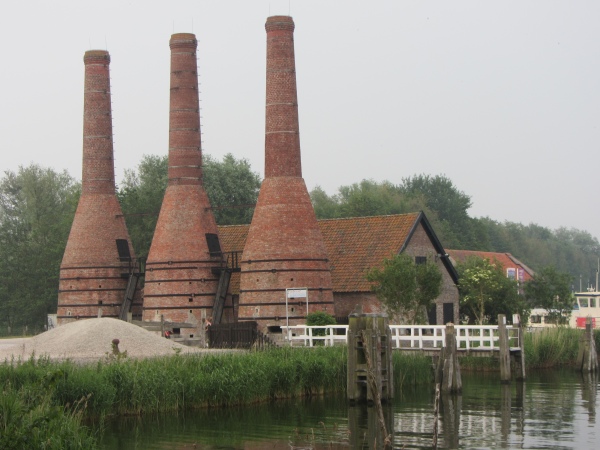
Sea Shell Kilns
|
Meryl had spotted a pair of museum assistants wandering around with umbrellas for visitors. We never did see them again. And so it came to be that we prematurely left the now almost deserted museum, rather wet, and getting wetter by the minute. We didn't visit the indoor part of the museum, we were soaked and just wanted to seek refuge and dry clothing in the boat. But despite the sorry ending, the outdoor museum had been an informative and enjoyable visit.
Later, when we thought the rain had eased off, we motored down to the far end of the marina to fill up with diesel. Rex made a perfect approach to the diesel pontoon and soon we were filling up with diesel. Then the rain suddenly returned in earnest, and as an added bonus, so had thunder and lightning. Imagine the scenario, three folk out in the rain pouring diesel into a bottomless tank in the thick of a thunderstorm. Once accomplished, we returned to our box, and not long afterwards we were ensconced in the marina restaurant, having a meal and washing/drying our clothes at the same time.
Meanwhile I received a call from Dan and Sally, my eldest two children, who were walking down the South Bank in London and were about to enjoy a drink. So there was some sunshine in Europe that day.
Late in the evening, a group of German guys on the next boat decided to party, no music, just incessant talking. I heard them long into the night, but I was too snug in my pit to bother with complaining.
21st June
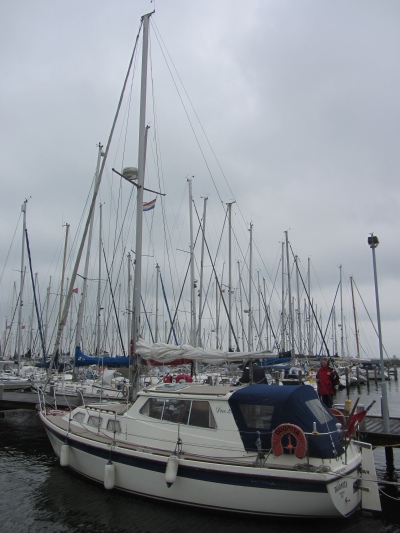
A Soggy Duonita
|
We awoke to the drumming of rain on the deck. The German party had subdued, but I later noticed a wheelbarrow by their boat, full of empty firkins of beer and wine bottles. Later, the hung over group took their boat out onto the Ijsselmeer; a pretty good cure for hangovers. The morning was truly grey and dismal, with the promise of much rain in the air. We had planned to visit Den Helder today to take in the Tall Ships event, but walking around outside in pouring rain suddenly lost its appeal, besides, we had already seen many of the tall ships heading to Den Helder. We furtively dodged torrential downpours to make forays into the shower block.
The deluge persisted through the day. Occasionally a shadowy figure, buried in oilskins, would pass our craft, leaning into the wind, and sometimes wheeling a suitcase in the direction of tera firma. Rex joked that they must be wives and girlfriends who had been driven to their limits by this aquatic torture, and hence decided to head for home. Many a true word said in jest.
The day passed by in a blur: Rex researching options for sailing back across the North Sea, Meryl booking a flight back to the UK, me catching up on my notes, engine maintenance, reading, catnapping and more reading. We had all brought out several books, but progress through them was still measured in chapters. Outside, the wind whistled through a forest of rigging and rain continued to pound on our boat. So much for the longest day of the year.
The rain eventually abated such that we made a foray into town and found an excellent, cosy restaurant by the Oude Haven, the
Markerwaard, housed in an old warehouse, and decorated with many maritime artefacts and ship models. The food and service was excellent, and we managed to sort out the geography of West Friesland with one of the waiters. We had been confused by this when talking to an old man in the Zuiderzee Museum, but now we understood that West Friesland is a small region squeezed between North Holland and the Ijsselmeer.
A couple rose to leave the restaurant, and as they passed by, the chap who shone piercing blue eyes out of a weatherworn face, stopped to have a chat. The couple were Scottish, the fellow, David, hailing from Aberdeen. The couple worked in Eindhoven, and were over here to check up on their flat. His poor wife never managed to get a word in edgeways. They left as quickly as they came, his wife playing a background role.

